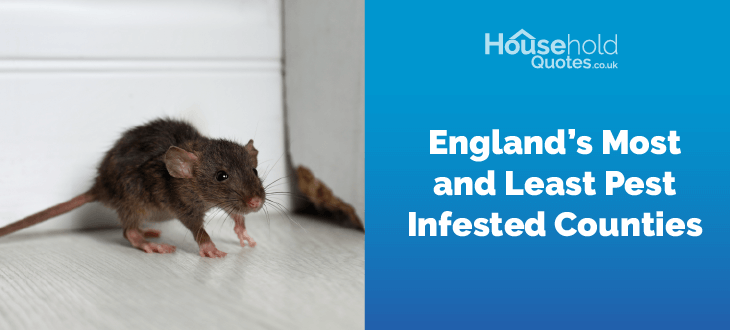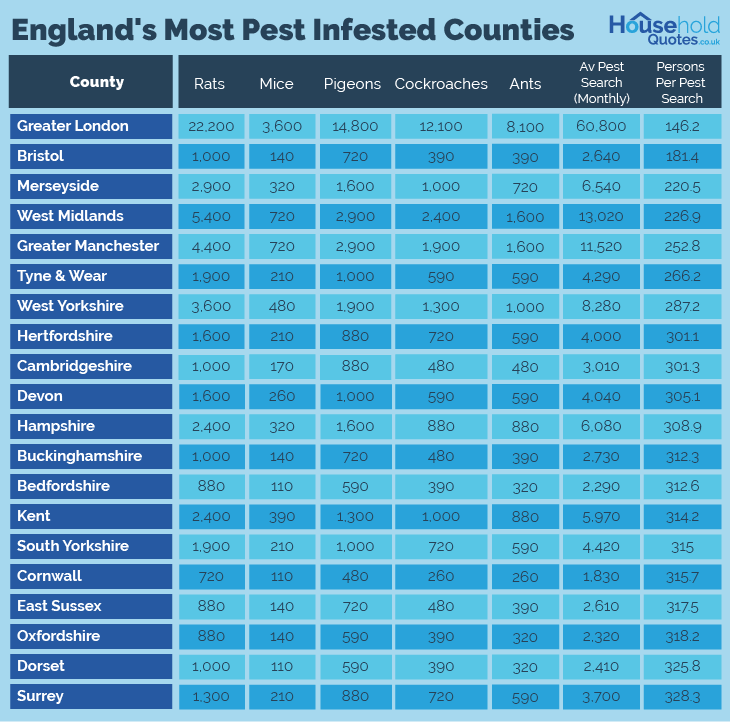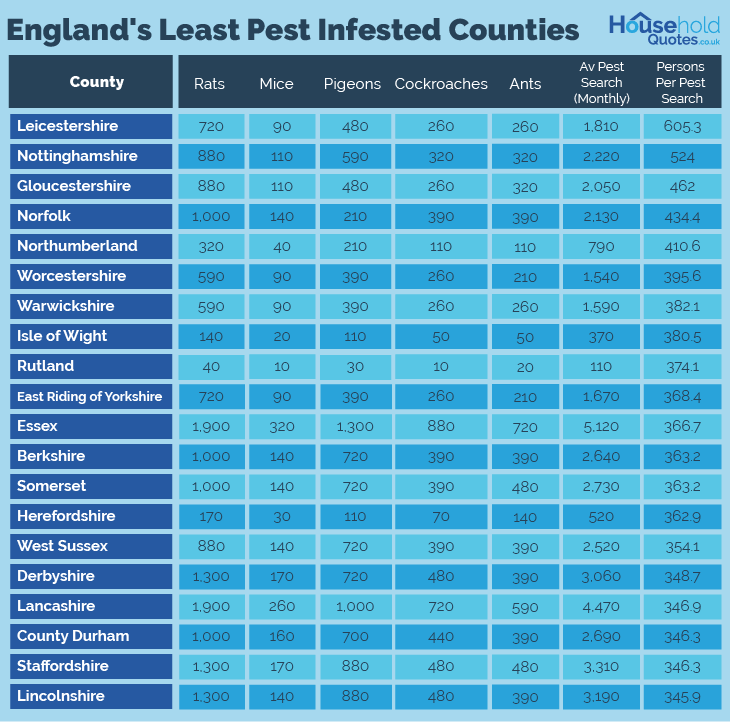- Householdquotes.co.uk
- Blog
- England’s Most and Least Pest Infested Counties
England’s Most and Least Pest Infested Counties


The last thing anyone wants in their home is unwanted guests, pests can be a real nuisance and prove difficult to eliminate. They like to bite holes through walls and furniture whilst scavenging for any leftover food. This is before the hygiene issues, rats and mice can carry deadly bacteria that if ingested could cause you to become severely ill. During the summer months, they are most active, so members of the public might be noticing increased pest problems at the moment.
Examples of pests include; rats, mice, ants, wasps, cockroaches and many more. Some are more of a concern than others and the risk you’re under from a certain pest could differ depending on where you live in England.
So here at Household Quotes, we decided to conduct an investigation into which English counties are the most and least pest-infested. We did this using Google search data which revealed how many people in each county were searching for different pests.

1. Greater London - 60,800 searches per month
Greater London is the capital city of the United Kingdom, and according to Road Genius, 20.3 million people visited in 2023. With a high amount of tourists, added to a large population of 8.9 million, this produces a lot of waste. It’s clear from these results that Greater London has a pest problem. It ranked as England’s most pest infested county in this study, with one in every 146 people researching pests each month.
2. Bristol - 2,640 searches per month
Bristol ranked as the second most pest-infested county in England. Located in the southwest, only a few miles away from the Welsh border, the City of Bristol has a population of just over 479,000. It’s popular with students, as it’s host to two universities, and this has given the city a reputation for partying and art. Rats and pigeons were the pests that particularly stuck out in the city’s average monthly search volumes, with there being 1,000 and 720 respectively.
3. Merseyside - 6,540 searches per month
Merseyside which is home to settlements including; Liverpool, St Helens and Birkenhead ranked as the third most pest-infested English county. Pigeons prove a real problem with around 1,600 searches a month on average. It was discovered that there is one pest search a month for every 220.5 people in Merseyside.
4. West Midlands - 13,020 per month
The West Midlands is home to England's second most popular city Birmingham. It saw high searches for pests like rats, pigeons, cockroaches and ants which was enough to place it as the fourth most pest-infested county. This could be down to the county being urban and very densely populated, offering more food sources to potential pests.
5. Greater Manchester - 11,520 per month
Greater Manchester is made up of many different towns and cities, including; Manchester, Salford, Bolton and Oldham to name a few. Due to the large population, and many frequented town centres, it may be no surprise that Greater Manchester was ranked fifth in this study. Like the West Midlands, Greater Manchester has a clear pigeon problem due to the sheer number of monthly searches (2,900).

1. Leicestershire - 1,810 searches per month
Leicestershire is located in the centre of England and contains many large settlements. These include; Leicester, Loughborough, Hinckley, Market Harborough and Melton Mowbray. It has been ranked as the least pest-infested English county in this study, with minimal search rates for pigeons (480) and rats (720) when compared to counties with similar populations.
2. Nottinghamshire - 2,220 searches per month
Nottinghamshire is a county notorious for the tales of Robin Hood, stealing from the rich and giving to the poor. They ranked second behind their neighbours Leicestershire in this study. The county is home to Nottingham, Mansfield, Newark and Worksop, all of which have town centres which are popular with locals. However, these settlements are more spread out than those in Greater Manchester and Greater London, which could be a big reason for the lack of pests in the county.
3. Gloucestershire - 2,050 searches per month
Gloucestershire is a pretty rural county and is renowned for its farmland. It hosts one of the most famous service stations in the UK, which sells a variety of local produce. It was ranked as the third least pest-infested English county in this study. Like Nottinghamshire, this could be down to its large rural population.
4. Norfolk - 2,130 searches per month
To find the fourth least pest-infested English county we need to travel to Norfolk in East Anglia. It’s particularly popular with tourists, with thousands heading to Cromer, Hunstanton and Great Yarmouth every year. It will come as a huge relief to farmers that Norfolk seems to have a low pest problem compared to the rest of the country. Norfolk has averaged 2,130 pest searches on average per month over the past year.
5. Northumberland - 790 searches per month
Northumberland is one of England’s border counties, it sits north of Newcastle and south of Scotland. Like many others in the top five, Northumberland is a very rural county, and according to the Telegraph, it is the least densely populated county in England. The county has an average pest search per month of 790, which is low even for the smaller population of around 320,000.
Joshua Houston, Pest Expert at Household Quotes:
‘’Pests are a real nuisance, so we were keen to see if pest problems differed depending on where you lived in England.
Through the results, you can identify areas with more pest concerns than others. A factor that might explain the differences is population density, as some counties are more rural and others are more densely populated.’’
Methodology
The English counties and their populations were gathered using statistica.
Google Ads was used to work out the average monthly search volume in English counties for selected pests over the past twelve months (June 2023 - July 2024). The terms searched were ‘Rats’, ‘Mice’, ‘Pigeons’, ‘Cockroaches’ and ‘Ants’, with the average monthly search volume for each added together for each county.
Finally, the population of the county was divided by the total number of searches for our identified pests, to come up with a ranking.
Data can be shared upon request.

Josh Houston is a writer at Household Quotes whose passionate about the world of renewable energy, energy saving solutions and home improvements. He specialises in providing useful tips that our readers can adopt for their own needs. His skills involve translating complex topics to something more understandable.
